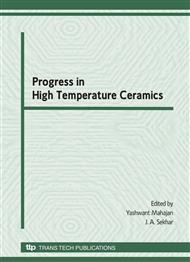[1]
S.C. Carniglia and G.L. Barna: Handbook of Industrial Refractory Technology, by Noyes Publications, ISBN 0-8155-1304-6, (1992).
Google Scholar
[2]
Refractory Handbook, The Technical Association of Refractories Japan, Tokyo, 104-0061.
Google Scholar
[3]
W.E. Lee and R.E. Moore: Evolution of in Situ Refractories in the 20th Century, Journal of the American Ceramic Society, vol. 81, 1385-410, (1998).
Google Scholar
[4]
I.P. Rubkevskii: Heat-Insulating Materials for High-Temperature Apparatus, Stroit. Materi. 2, 1986, 21.
Google Scholar
[5]
L.A. Dergaputskaya, A.N. Gaodu, and L.G. Litvin: Anorthite Light-Weight Refractories for Service in Carbon-Containg Media, Ogneupory, 1980, 40.
DOI: 10.1007/bf01402764
Google Scholar
[6]
F.F. Sigulinski, I. Stamenkovic, Pl Martinovic, R. Stefanovic, and V. Vucovic: Theoretical and Practical Approach to the Selection of the Granulometric Composition for Permeable Refractory Synthesis, Ceramurgia 9, 1979, 51.
Google Scholar
[7]
V.L. Bulakh, R.F. Rud, T.S. Penzeva, and B.V. Belokon: Tests of Unfired Siliceous Products as Linings of Steel-Teeming Ladles for Electrically Melted Steel, Ogneupory, 1987, 40.
DOI: 10.1007/bf01403218
Google Scholar
[8]
M. Wismer: Inorganic Foams, Plast. Foams Monogr. 1, 1973, 805.
Google Scholar
[9]
G. Popa, C. Dragomir, A. Szabo, M. Diaconescu, and C. Enastescu: Heat -Insulating Products Prepared by Chemical Foaming, Cercet. Metal. 27, 1986, 47.
Google Scholar
[10]
K.J. Konsztowicz: Acoustic Emission from Thermal Fracture of an Advanced Zirconia Refractory, 1783 (in ref. 26).
Google Scholar
[11]
H. Ninomiya and H. Itaya: Fibrous Fire-Resistant Material, Kogyo Kanetsu 22, 1985, 25.
Google Scholar
[12]
KZakrzewska: Polycrystalline Alumina Fibers for Applications at Temperatures up to 1600 Degree C, Mater. Ogniotrwale 35, 1983, 31.
Google Scholar
[13]
M. Hayase, H. Asami, H. Asakura, and T. Saeki: Development of Zirconia Fiber and its Application, Shinagawa Giho 31, 1988, 129.
Google Scholar
[14]
A. Smrcek: SIBRAL - Manufacture, Properties, and Varieties, Stavivo 62, 1985, 360.
Google Scholar
[15]
R.D. Smith: Thermal Sability of Polycrystalline Fiber/Ceramic Fiber Blended Product Forms, 607 (in ref. 75).
Google Scholar
[16]
N.J. Rossi and W.A. Schreifels: Cerabond II: Spray Applied Refractory Fiber Insulation, International Symposium of Advanced Refractory and Metallic Industry, 1988, 267.
Google Scholar
[17]
R. Ganz and W. Kroenert: Crystallization Behavior of High-Temperature Ceramic Fibers of the Aluminum Oxide-Silicon Dioxide System, InterCerm 31, 1982, 136.
Google Scholar
[18]
Annual Book of ASTM Standards, Vol. 15. 01, 1990 (re-issued annually), American Society for Testing & Materials.
Google Scholar
[19]
G.K. Lemasters, J.E. Lockey, L.S. Levin, R.T. McKay, C.H. Rice, E.P. Horvath, D.M. Papes, J.W. Lu, and D.J. Felderman: An Industry-Wide Pulmonary Study of Men and Women Manufacturing Refractory Ceramic Fibers, American Journal of Epidemiology, vol. 148 no. 9, 910-19, (1998).
DOI: 10.1093/oxfordjournals.aje.a009717
Google Scholar
[20]
S. Penumella: Compositions for and Synthesis of Improved Insulations, U.S. Patent 6, 113, 802, Issued Sept. (2000).
Google Scholar


